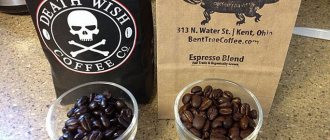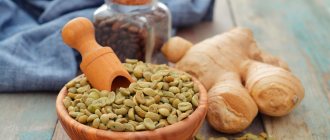There are no comrades according to taste - the good old truth, which is confirmed every day. Coffee is no exception; each lover has his own recipe, preparation method and preferred variety. However, the world of coffee has its own recognized leaders, standards and samples of taste. Colombian coffee is first among equals. It is so popular and in demand that in 2007 the trademark “Colombian Coffee” was registered, which applies only to beans grown in the country. The coffee growing region in Colombia is classified as a UNESCO World Heritage Site. Why is Colombian coffee so good?
Arabica coffee Colombia – a chronicle of the coffee years
Do you remember all the events in your life that happened from infancy to the present day? Probably not, because memory is selective. A similar situation arises with the emergence of coffee culture in different countries. Not always, and most often one might even say very rarely, there is accurate information about the appearance of coffee beans or bushes on a given land.
For example, the laurels of primacy in growing coffee crops in Colombia are supposedly attributed to the Jesuit monks. At least, there are records of the book “Picturesque Orinoco” (author José Gumilla) dating back to 1730, which speaks of certain plantations laid out on the banks of the river. Adding to the treasury of evidence is a report by Archbishop Antonio Caballero y Gongora from 1781, which speaks of the active cultivation of coffee crops in the northeast of the country. It is rumored that in those days even sinful parishioners received atonement for their sins in the form of planting coffee trees and caring for them.
Be that as it may, the existence of coffee plantations remained a mystery to many. High demand for Colombian coffee beans was noted only in the 19th century. It was at that time that the Colombians actively adopted the experience of Western countries, and it was then, in 1835, that the first commercial plantation was organized. The supply of coffee for export through the port of Kakuta began to be established. However, at first they remained at the same level due to the interest of Colombians in the production of other local goods.
Things took off only in the 20th century, when the areas occupied by coffee crops expanded, and it began to be grown in Caldas, Santander and in the northern part of Tolima. A decisive event in the life of coffee with a Colombian character was the founding in 1927 of the FNCC, the National Federation of Coffee Growers of Colombia. Engaged in strict quality control of products, it allowed local products to become famous throughout the world. In 1930, Colombia became a leader in coffee production, and in 2007, Colombian products became an official brand. Thus, today Colombia is the silver medalist of coffee exporting countries, accounting for 15% of total production and 4.5 million hectares of land occupied by coffee plantations.
Grain processing
In Colombia, as in other countries, the most common method for processing grains is mainly used. When the crop is harvested, everything unnecessary is removed from the fruits of the coffee tree: leaves and twigs, and then the skin and pulp. After this, the grains are left to dry in the sun. The equatorial sun completes the processing process.
Today there are not many large industries in the country that use the more modern and expensive wet processing method. In this case, the berries are fermented and not dried in the sun, which, in theory, preserves a richer taste and aroma.
Most of the producers are mainly small farms, operate according to the old method and preserve the traditions as they were 100 years ago.
Subtleties of production of Colombia coffee beans
There are countries that can be said to be born for growing coffee. Colombia, with its temperate equatorial climate, average annual precipitation and friendly rays of the sun, is one of them. Despite the active cultivation of coffee trees throughout Colombia (7 regions of the country are involved in this activity, where 85% of the total coffee comes from MAM - the central Colombian region), raw materials from the foot of the Andes are considered the most valuable. Growing at an altitude of 1200 - 1800 meters above sea level, it gains strength here under the canopy of spreading trees. High clouds promote light scattering. As a result, the coffee beans ripen evenly, and the taste of the drink, brewed from Colombian coffee varieties, is distinguished by its softness.
The cultivation and production of Colombian coffee beans is often carried out by small farms. Often allocating land of no more than 2 hectares for coffee crops, they honor family traditions and supply the market with amazingly high-quality organic coffee. By the way, the following varieties of varieties are known here:
- Supremo – large grains (6.5 – 8 mm) of the highest quality with soft acidity, balanced taste and memorable aromas;
- Extra is a high-quality product, slightly inferior in aroma and taste characteristics to the previous type;
- Excelso is a medium-sized bean coffee (6 – 6.5 mm), which is the result of mixing supremo and extra. Presented with selected Arabica coffee, subjected to medium roasting, it surprises with its acidity and a hint of prunes in the taste.
- UGQ/UNO - coffee products, also classified as premium quality raw materials (5.5 mm).
At the same time, Arabica is predominantly represented in Colombia. These include Tabi, Bourbon, Typica, Colombia and Castillo varieties. They are supplied to the market in different forms. Both the pure product and local mixtures of Bogota, Colombia Excelso, Medellin, Narino and others are popular.
The yield of Colombian coffee is approximately 930 kg of coffee products per hectare. Moreover, to obtain 1 kilogram of coffee raw materials, you need to process 5 kilograms of coffee berries. One tree can produce such a harvest once a year.
As expected, coffee raw materials are collected as they ripen. Cleaned of twigs and leaves that inadvertently fall into coffee baskets during assembly, it is sent to “beneficio” - the process of processing the coffee fruit, including depulping (cleansing of pulp), washing and drying. The stage of “soaking” coffee in running water takes 12–36 hours and is carried out for the purpose of:
- carry out the final “depulpation”;
- weed out low-quality, floating grains;
- activate the fermentation process, allowing the coffee bean to acquire a specific taste and aroma.
Next, the coffee beans are dried under the diffused rays of the sun. The pulp is subsequently sent to fertilize the soil, and the dried coffee beans are packaged in parchment packaging. Before coffee is put up for sale, it goes through 14 levels of quality control. The final product will be sorted into bags with the image of a Colombian coffee brand - a man in a floppy hat named Juin Valdez and his mule.
Features of coffee cultivation
Coffee is grown primarily on small farms owned by private individuals. The main varieties of coffee grown in the country are Castillo and Caturra. The first of them is a variety specially bred by Sanicafe. It is resistant to swarming, a disease that affects coffee trees. The second is characterized by high productivity. Some farmers also cultivate varieties such as Geisha, Colombia, Typica, Bourbon and Rume Sudan, which produce coffee with a special taste. In particular, the Colombia variety is characterized by fruity sourness, caramel taste and cocoa aroma, while Typica is characterized by a classic coffee taste with a nutty note and a slight bitterness.
Coffee plantations are often located on mountain slopes, so the coffee is harvested by hand. Due to the fact that the country, on the one hand, is located on the equator, and on the other, its territory has various and quite significant differences in elevation, it is possible to harvest crops throughout the year. At the same time, there are two periods in the country when the harvest takes place.
- The main harvest is the period most favorable for harvesting coffee and allows you to collect a larger number of coffee berries. Coffee collected at this time is considered to be of higher quality.
- The second harvest (mitaka) is a less productive period, the quality of the berries collected at this time is not as good as during the main harvest.
Harvesting coffee berries requires a large amount of labor, because... it is necessary to collect on time and correctly. The berries should not be allowed to become overripe, otherwise this will affect the quality of the coffee.
On average, farmers manage to collect 1 kg of green beans from one coffee tree, which is about 850 g after roasting. If we take medium-sized plantations, then one such plantation brings up to 7000 kg of green grain per season.
Popular varieties of Colombian coffee beans
Coffea arabica or Arabian tree is the only type of coffee crop grown in the mountains of the South American country. The import of robusta into Colombia is prohibited. In order not to uproot many years of work in the field of coffee breeding, scientists are “afraid” of Coffea canephora (Congolese tree) like the devil of incense. After all, to this day the fruits of their labor are represented by the coffee elite. The pride of Colombia and the world of professional coffee lovers and cup testers are the following varieties:
- Bogota is the highlight of Colombian coffee, named after the country's capital. Loved for the drink’s delicate almond flavor and lack of bitterness and sourness, it is rightfully considered the pride of the people of Colombia.
- Narino is an equally popular coffee variety and the base of the Starbucks coffee product. Grown in the province of Narino of the same name, it offers gourmets the opportunity to appreciate the aristocratic taste and pleasant aroma of freshly brewed coffee.
- Colombia Excelso is a coffee that is sought to be grown on the slopes of the Andes. Enjoyed by coffee lovers, this Colombian Arabica coffee is the product of strict quality control by the relevant authorities.
- Popayan Excelso is the Colombian exception to the rule. Different from its coffee compatriots, it gives off the bitter taste and thickness of a freshly brewed drink.
- Bucaramanga is a coffee product native to the Eastern Cordillera. Growing next to banana palms, it is famous for its delicate interweaving of orange and jasmine flavor notes, as well as a delicate aroma mixed with notes of roasted beans and honey.
- Castillo is a variety that has undergone serious prevention of coffee diseases. Attracting the attention of coffee lovers with its delicate taste, it surprises with its nutty flavor when milk is added to the drink.
Well, how can you ignore Maragogyp Colombia and Colombia Antioquia Finca San Pascual! The first coffee variety is represented by incredible large coffee beans, which are a temporary phenomenon. The second grade of Colombia coffee is the product of exceptional dry processing of the beans. Exclusive due to production processes unusual for Colombian coffee, it produces medium sweetness and a slight roasted grain flavor.
Historical reference
Coffee cultivation first began in Colombia back in the 17th century.
But it was not until the 19th century that the first commercial plantation appeared. It gave a very small harvest of 2-3 bags per year. Although the product was an export product, Colombian tobacco and rubber were in much greater demand.
And only thanks to one nuance, Colombian coffee managed to take a leading position in the world market. The combination of climatic conditions with the peculiarities of the composition of the local soil makes it possible to grow grains of outstanding taste.
Cost of exclusive coffee varieties Colombia
Having absorbed with their mother's milk the love for real bean coffee, coffee lovers never waste time on trifles. Their main principle is that more is better, but less. Giving preference to elite varieties, they are looking for softness of taste and the opportunity to swim in the wave of an aromatic drink. A clear embodiment of their desires are the following varieties of Colombian coffee from the Moscow online store “Tastybar”:
| Colombia La Jolleria - an original mix of chocolate and lime notes, available at a price of 235 rubles per 100 grams; |
| Colombia Supremo is the most caffeinated variety of the South American country, sold at a price of 143 rubles per 100 grams; |
| Maragodzhip Colombia is a unique coffee raw material that produces a rich drink with notes of fruit and baked milk (cost per 100 grams is 285 rubles); |
| Colombia Geisha Finca Inmaculada - elite Colombian coffee, recognizable by its fruity sourness and exquisite aroma of tea rose (price - 428 rubles per 100 grams); |
| Colombia Excelso is a noteworthy coffee variety with a subtle interweaving of fruity sourness and notes of cocoa (cost per 100 grams - 147 rubles). |
The online store of coffee beans “Tastybar” is responsible for the quality and freshness of each of the above coffee products. Proper storage of coffee beans, skillful roasting and prompt delivery of the order to the client is a guarantee of receiving what you were looking for!
Colombian Arabica coffee - a recipe with a local twist
It would be strange to find out if in a country that is one of the top three coffee producers, they prefer something else as a drink. Yes, they love coffee here and drink it with pleasure throughout the day. In the morning, this could be a cup of hot drink purchased from a street vendor for $0.5 - $1, or an espresso/Americano purchased in a cafe for $1 - $1.5. Wealthier citizens wait for the opening of elite coffee shops (they are open from 12.00) and buy a coffee drink there for every taste. The price for it ranges from $2 to $5.
Particularly popular is the so-called “tinto” – a cup of black coffee flavored with cane sugar. Despite the large volumes of coffee production in Colombia, most of it is exported abroad. That is why people here drink coffee drink more often than natural coffee. Be that as it may, the tradition of making real, delicious coffee has not bypassed this country. So, one of the unique ways to prepare coffee in Colombia is as follows:
- Heat an empty copper pot on the stove.
- Depending on the number of cups of hot drink you want, pour freshly ground coffee into it at the rate of 2 teaspoons of coffee powder per 1 coffee cup.
- Fill the coffee with water.
- Add sugar to taste.
- Place on the fire and bring to a boil.
- As soon as the coffee foam begins to rise, remove the drink from the heat.
- Coffee is poured into cups, and several coffee beans pre-dipped in melted chocolate are placed next to them on a saucer.
It is recommended to wash down every two sips of Colombian coffee with 1 sip of cold water. According to experts, this not only helps to fully reveal the aroma and taste of the drink, but also eliminates the possibility of heartburn and nausea. To ensure that coffee contains less caffeine, oxalic acid and purine bases, Colombian coffee is boiled only once.











